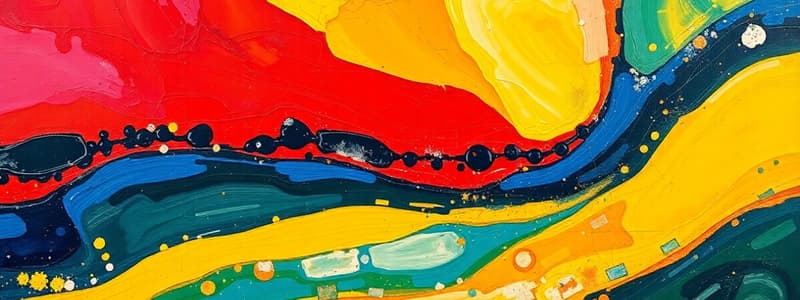Podcast
Questions and Answers
Which type of plant flowers when the night length exceeds its critical photoperiod?
Which type of plant flowers when the night length exceeds its critical photoperiod?
- Long-day plants
- Day-neutral plants
- Short-day plants (correct)
- Mesophytes
What term describes organisms that can thrive in low temperature environments?
What term describes organisms that can thrive in low temperature environments?
- Mesothermal
- Polythermal
- Eurythermal
- Oligothermal (correct)
Which of the following factors is primarily influenced by the length of day or night?
Which of the following factors is primarily influenced by the length of day or night?
- Water availability
- Temperature regulation
- Soil composition
- Photoperiodism (correct)
Which type of plant is adapted to grow in water?
Which type of plant is adapted to grow in water?
What is the term for plants that thrive in extremely dry conditions, such as deserts?
What is the term for plants that thrive in extremely dry conditions, such as deserts?
Which of the following is NOT a limiting factor on land ecosystems?
Which of the following is NOT a limiting factor on land ecosystems?
Day-neutral plants flower based on which of the following criteria?
Day-neutral plants flower based on which of the following criteria?
Which type of organism can thrive in environments with very high temperatures?
Which type of organism can thrive in environments with very high temperatures?
What does Liebig's Law of Minimum state?
What does Liebig's Law of Minimum state?
Which statement best describes the law of tolerance?
Which statement best describes the law of tolerance?
Which of the following is NOT a principle of the law of tolerance?
Which of the following is NOT a principle of the law of tolerance?
What ecological factor is NOT emphasized in relation to land?
What ecological factor is NOT emphasized in relation to land?
What is the photic zone?
What is the photic zone?
Which of the following best describes ectothermic marine organisms?
Which of the following best describes ectothermic marine organisms?
Which type of tolerance relates to the ability of organisms to survive varying environmental conditions?
Which type of tolerance relates to the ability of organisms to survive varying environmental conditions?
Which statement about reproductive individuals is true according to the principles of tolerance?
Which statement about reproductive individuals is true according to the principles of tolerance?
Flashcards
Limiting Factor
Limiting Factor
A resource or environmental condition that restricts the growth or distribution of an organism or population.
Liebig's Law of Minimum
Liebig's Law of Minimum
Growth is limited by the scarcest resource, not the total amount available.
Law of Tolerance
Law of Tolerance
Organisms have tolerance limits for environmental factors (too little or too much).
Steno
Steno
Signup and view all the flashcards
Eury
Eury
Signup and view all the flashcards
Photic Zone
Photic Zone
Signup and view all the flashcards
Aphotic Zone
Aphotic Zone
Signup and view all the flashcards
Ectothermic
Ectothermic
Signup and view all the flashcards
Endothermic Marine Organisms
Endothermic Marine Organisms
Signup and view all the flashcards
Photoperiodism
Photoperiodism
Signup and view all the flashcards
Long-day plants
Long-day plants
Signup and view all the flashcards
Short-day plants
Short-day plants
Signup and view all the flashcards
Xerophyte
Xerophyte
Signup and view all the flashcards
Mesophyte
Mesophyte
Signup and view all the flashcards
Oligothermal organism
Oligothermal organism
Signup and view all the flashcards
Soil
Soil
Signup and view all the flashcards
Study Notes
Limiting Factors
- In biology, a limiting factor is a resource or environmental condition that restricts the growth, abundance, or distribution of an organism or a population.
- Liebig's Law of the Minimum states that growth is controlled by the scarcest resource, not the total amount available.
- Shelford's Law of Tolerance suggests that too little or too much of a factor can limit growth, not just too little.
- Organisms can have wide tolerance for some factors, but narrow tolerance for others.
- Organisms with wide tolerance ranges are typically more widespread.
- When one factor is not optimal, tolerance for other factors might decrease.
- Organisms are often not living at the optimal range of physical factors.
- Reproductive stages (seeds, eggs, embryos) generally have narrower tolerance ranges compared to adults.
Physical Factors
- Light:
- The photic zone is the depth to which light penetrates, supporting photosynthesis and primary production.
- Temperature:
- Most marine organisms are ectothermic, having their body temperatures match the surrounding water.
- Some are endothermic, maintaining a higher body temperature than the surrounding water (e.g., marine mammals, birds, some sharks).
- Salinity:
- Pressure:
- Oxygen: Important in freshwater environments.
- Dissolved Nutrients: Essential for plant growth.
Limiting Factors on Land
- Photoperiodism: A physiological reaction to the length of day or night.
- Long-day Plants: Flower when the night length is below a certain threshold. (Examples during specific seasons for specific regions.)
- Short-day Plants: Flower when the night length exceeds a certain threshold.
- Day-neutral Plants: Flowering is not dependent on day length.
Water Factors
- Xerophyte: Plants adapted to dry conditions (e.g., deserts).
- Mesophyte: Land plants adapted to moderate moisture.
- Hydrophyte: Plants adapted to aquatic environments.
Temperature Factors
- Oligothermal: Organisms thriving in very low temperatures.
- Polythermal: Organisms thriving in very high temperatures
- Mesothermal: Organisms adapted to medium temperature ranges.
Soil
- Soil is a mixture of minerals, organic matter, gases, liquids, and organisms.
- Soil layers include topsoil (rich in humus and minerals), subsoil, weathered rock, and bedrock.
Studying That Suits You
Use AI to generate personalized quizzes and flashcards to suit your learning preferences.




